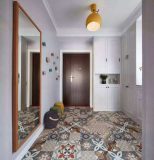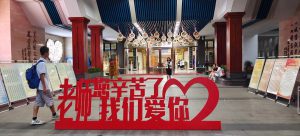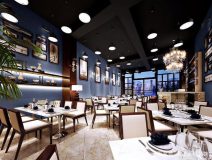Title: Information city — Shared emotions under masks
City: Hangzhou
Site: Corridor
Directed by: Lin Liya 3035952018
Hypothesis
Theoretically, corridors are a form of the hallway that is typically narrow compared to its length and acts as a passage connecting different parts of a building. They seemed ordinary and easily overlooked in our modern city. Sometimes corridors are considered as soulless ‘between’ spaces with no particular character or functions. They separate the private and public spaces and the occupants of a building. However, a question comes to my mind: Do corridors really have no other function except for a connecting structure in buildings?
Method of conducting the research
I began to search on the internet for different functions of corridors in different spaces. And I found an interesting phrase -corridor culture. This phrase reminds me of my high school; we used to have competitions for each floor’s decoration. It shows that every space can have an utterly different corridor culture, even different levels in our dormitory can have different cultures. Take our level as an example; we take fire as our theme. Whenever I enter our level, I feel a strong sense of belonging.
Theme&Subject
Different buildings have different uses. Corridors are also quite different in that case. Hence, I decided to compare different corridor cultures along with their functions by researching them more deeply. Hangzhou is a suitable information city to do this research. However, due to the pandemic regulations in Hangzhou, it isn’t easy for me to visit some buildings in person, such as schools, so I decided to do my research both virtually and practically. And in order to better shows the feeling it gives to people, I take my video from the first-person perspective when walking through those corridors. For those spaces I’m able to visit, I’ll go in person. If not, instead, I’ll search for more information online.
At first, I look at the corridor in my apartment. It’s a narrow and disconnected corridor, with white walls and almost no decoration. There are several storehouses and emergency exit alongside. Then I enter our home; the corridor is also narrow, but with some paintings hanging on the walls, which can build the house’s atmosphere, also indicates the taste of the house-owner. This is because everyone will see the corridor at first glance when they enter one’s apartment. Compared to pictures of other apartments’ indoor corridors, the main similarity I found is that they are decorated with paintings, drawings, even a mirror, etc. These tiny elements can show the style of that space.

The corridors in schools are quite different from the apartment. As for the teaching buildings, Kindergartens’ corridors are more colorful, with some fairy tales or cartoon characters. Children at that age are full of fantasy about the future. Therefore, those kinds of corridors can expand their imagination. Besides, the hallways of higher-level schools are more likely to be decorated with sample writings, calligraphy, painting, stirring words, pictures, as well as some meaningful items.
For example, my brother’s high school put the name lists of Outstanding Students and slogans along the corridor. These can encourage students to study harder, and those quotes can also show the feature of the school. Along with some great paintings of his schoolmates can add some exciting elements.

Unlike the teaching buildings, the corridor of the dormitory building tended to be cleaner and more ordered, sometimes with some unique decorations but not much. To some extent, it indicates the characteristics of our society, which are pursuing discipline, order, and efficiency. Japan is entirely different from our culture, which can be told from their decorations; their walls, doors, and even stairs are full of colorful ornaments and murals. By research, the function of the dormitory in Japan is more likely to reduce the pressure on students instead of regulating them. It is a pretty interesting phenomenon to use corridors to tell the characteristic of different societies.

Then, I start to research the corridor of hospitals, which are a lot wider than in schools or apartments. This aims to provide enough space for some emergent patients with their beds. I also found that the walls are always covered with white or green colors, which can calm the patients, instead of those depressing dark colors.
The restaurant’s hallway is supposed to increase one’s appetite. According to the survey, fast-food restaurants’ walls and layout of corridors generally use red or yellow. The purpose is to let guests eat more quickly. And the formal restaurants are more likely to use balanced warm and cool colors that customers will feel comfortable with. Colour – A simple element of corridors – can affect the speed a person eats and their mood, which shows that the corridors unknowingly influence us in many ways.


To sum up, although the corridors seem to be just a simple structure of every space, the information they provide unconsciously influences us in many aspects of our lives. We underestimate their function in many cases.
Word count: 800
References:
Priemus, Hugo & Zonneveld, Wil. (2003). What are Corridors and What are the Issues? Introduction to Special Issue: The Governance of Corridors. Journal of Transport Geography – J TRANSP GEOGR. 11. 10.1016/S0966-6923(03)00028-0.2.LAWLER, A. (2010). <strong>A Forgotten Corridor Rediscovered</strong>. Science, 328(5982), 1092–1097. http://www.jstor.org/stable/40656294
Jarzombek, M. (2010). Corridor Spaces. Critical Inquiry, 36(4), 728–770. https://doi.org/10.1086/655210
What is the Difference Between Corridor and Hallway. link:https://pediaa.com/what-is-the-difference-between-corridor-and-hallway/
LAWLER, A. (2010). <strong>A Forgotten Corridor Rediscovered</strong>. Science, 328(5982), 1092–1097. http://www.jstor.org/stable/40656294
Natural Resources Conservation Service (NRCS). link: https://www.nrcs.usda.gov/Internet/FSE_DOCUMENTS/nrcs144p2_015351.pdf

Name: Liya Lin
UID:3035952018
I think you give out an idea that a corridor is a place to conduct information. Even though it may not contain words or images on the walls, the color of the corridor also can provide information and change people’s moods. I think this is an aspect that would be ignored when talking about the corridor.
Also, I think you show the contrast of corridors between public space and private home; kindergarten and high school; fast-food restaurants and formal restaurants. I like the idea of comparison; the audience can easily understand the different functions of different corridors.
wow, great work! I never really thought about the role of corridors in our lives until I watched your video eassy. I agree with what you said about creating a strong sense of belonging when entering the hallway. It also reminded me of the long green corridor when I took the elevator from the University of Hong Kong MTR station to the campus. Although it is unremarkable to others, our memory can actually connect this corridor with the university, which is why I quickly enter the state of learning when I pass through this green corridor. This is also another aspect of the impact I think corridors have。
wow, great work! I never really thought about the role of corridors in our lives until I watched your video eassy. I agree with what you said about creating a strong sense of belonging when entering the hallway. It also reminded me of the long green corridor when I took the elevator from the University of Hong Kong MTR station to the campus. Although it is unremarkable to others, our memory can actually connect this corridor with the university, which is why I quickly enter the state of learning when I pass through this green corridor. This is also another aspect of the impact I think corridors have.
Your video is creative and go through with a wonderful angle. The idea that the role of corridors in our lives provide the sense of belonging is also creative. We could see corridors all over the cities, but in most times we like to ignore it. Thank you for reminding me the ignored beauty in life. Your video is really helpful.
This video essay is remarkable in that it sheds light on some often-neglected aspects of the corridor, which is much more important than we think it is in our everyday life. I was especially surprised by how different elements of the corridor subtly shape our perception of space in general and how such elements have been taken advantage of by architects and designers in order to produce the desired effects. I have seen a lot of corridors (as has done everyone), but I have never approached them from the perspective so effectively presented in this video essay. I also like it that you have touched upon the subject of color, which, despite its importance, is easy to overlook. Overall, I enjoy the content and the creativity of your video.
I appreciate that you notice the cultural connotation of the corridor in addition to its practical function, which expands the perspective of discussing corridor space. Under the limited site accessibility, it is feasible to use the combination of real-site shooting and secondary image materials. However, the second-hand footage in your film already occupies at least half of the content, which affects the originality of your work. Also, I recommend doing dynamic video captures rather than transiting still photos, otherwise, your video will be more like a slideshow than a film.